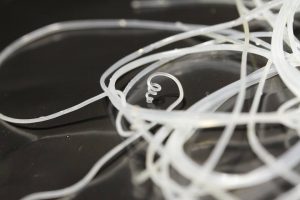Dirofilariasis of dogs
 What are heartworm dogs in dogs?
What are heartworm dogs in dogs?
Dirofilariasis is caused by round worms of the species Dirofilaria immitis. These chevries live in the right chambers of the heart and pulmonary arteries of infected dogs. You can imagine how badly the lungs and hearts of dogs can be affected by dirofilaria …
It is impossible to just look at the dog and understand that it has dirofilariasis, as if it were a question of fleas and ticks. Symptoms appear months after infection.
Life cycle dirofilaria
Dog dirofilariasis – development cycle
The intermediate owner is a mosquito. The mosquito swallows young dirofilaria, which are called microfilariae along with the blood of infected dogs. Further dirofilaria develop in the body of a mosquito. Then the mosquito bites a healthy dog, infecting it with dirofilariasis.
The dog develops further dirofilaria. In the end, dirofilariae penetrate the heart and pulmonary arteries, where puberty occurs.
Adult dirofilariae reach 10 – 30 centimeters in length. It happens that more than 250 worms are found in one dog. Adult worms mate; one female can release 5,000 microfilariah per day in the dog’s blood.
Dirofilariasis of dogs in Russia
These microfilariae must be swallowed by a mosquito in order to develop further and the disease continues to spread among dogs. Microfilariae can wait for an opportunity in the blood of a sick dog to 3 years!
The life cycle of a worm takes 6-7 months. Infected dogs may not have any symptoms for many years.
Symptoms of dirofilariasis in dogs
Heartworms can live in a dog up to 5 years. At the initial stage, the dog does not show signs of disease. But over time, symptoms appear and the condition worsens. Common symptoms of dirofilariasis:
Cough
Rapid breathing
Reduced activity
Lethargy and weakness
Apathy
Weight loss
Coughing up blood
In the late stages of the disease:
Chronic heart failure
Collapse
Death
If the dog has similar symptoms, we recommend that you make an appointment with a veterinarian cardiologist.
Diagnosis of dirofilariasis
A blood test for microfilariae – a doctor takes a blood sample and searches for microfilariae under a microscope
Blood test for the presence of dirofilaria antigen. Allows to detect adult dirofilaria in the heart, even if they do not produce microfilariae.
X-ray and echocardiography (ultrasound of the heart) – can detect adult dirofilaria in the heart and blood vessels
After diagnosis, dogs are classified in one of the following categories:
Category 1: the initial stage of the disease without symptoms or with minimal manifestation, without visible damage to the heart
Category 2: symptoms of moderate severity or intermittent. The condition of the dog is generally good, there are problems with the heart.
Category 3: serious dog health problems.
Category 4: caudal vena cava syndrome, collapse and fast death without emergency surgical removal of worms.
Treatment of Dirofilariasis
Treatment is carried out depending on the stage of the parasite in the dog.
If there are already adult worms in the dog’s heart and vessels, then at first they can be “weakened” and reduced in number. Some drugs for the prevention of dirofilariasis can help. Additionally, Ronaxan (doxycycline) is also used to destroy Wolbachia, bacteria living in dirofilaria, without which these worms reproduce poorly and grow. For the destruction of adults dirofilaria use melarsomina dihydrochloride (Immititsid, not registered in Russia). As an alternative with a longer treatment using drugs based on ivermectin.
Prevention of dogs dirofilariasis
Today there are two options: the use of repellent for scaring dogs and / or a drug to destroy microfilariae in the blood of dogs.
As a repellent can be purchased at the veterinary pharmacy Front Line Tri-Act, which in addition to scaring mosquitoes, scares and destroys fleas and ticks.
Frontline Tri-Act – pipettes from ticks, mosquitoes and fleas
To destroy the larvae in the blood – Nexgard Spectra – a pill against fleas, ticks and worms, also aimed at protecting against dirofilariasis. Nexgard Spectra is also used for the prevention of babesiosis, for protection against ticks, fleas, helminths
Nexgard Spectra – a tablet for fleas, ticks and worms
Both drugs can be used puppies from 8 weeks of age.
It is important to carry out prevention on a monthly basis, starting one month before the flight of mosquitoes and ending one month after the termination of their flight.
It is recommended to conduct a blood test of all dogs once a year for infection with dirofilariasis, regardless of whether you are using prophylactic drugs or not.



